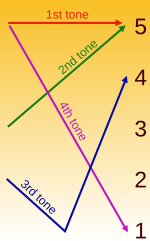This article needs additional citations for verification. (November 2006) |
| Shenyang Mandarin | |
|---|---|
| 瀋陽話 / 沈阳话 Shěnyánghuà | |
| Native to | China |
| Region | Shenyang |
Sino-Tibetan
| |
| Language codes | |
| ISO 639-3 | – |
cmn-she | |
| Glottolog | shen1252 |
Shenyang Mandarin (Chinese: 沈阳话) is a dialect of Northeastern Mandarin used by people in and around Shenyang, the capital of Liaoning province and the largest city in Northeast China. It is very close to Standard Chinese but has some notably distinctive words. Some people consider it a strong accent rather than a distinct dialect. Because of its similarity to the standard language, pinyin can be used to represent its pronunciation. Its usage is dwindling as schools in Shenyang teach only the standard language.

The most distinctive aspect of the Shenyang dialect is the much lower pitch of the first tone than in Standard Mandarin. It would be positioned at 2, rather than 5, on the chart shown (right). As a result, it can sound rather like the third tone.
Like the Beijing dialect, the Shenyang dialect is characterized by erhua (儿化).
Some of the words in the Shenyang dialect come from other languages like the Manchu language. One example is 旮旯儿 gālár 'corner'.
Examples of words in various Northeastern dialects (not necessarily specific to Shenyang) include:
| Northeastern Mandarin | pinyin | Standard Mandarin | pinyin | Translation |
|---|---|---|---|---|
| 不赶趟儿 | bù gǎntàngr | 来不及 | lái bù jí | too late |
| 波楞盖儿 | bōlingàr | 膝盖 | xīgài | kneecap |
| 疙瘩、圪塔[citation needed] | gāda | 地方 | dìfang | place (noun) |
| 得瑟 | dèse | 卖弄 | màinòng | to show off |
| 老鼻子(了) | lǎobízi(le) | 很多 | hěnduō | a lot |
| 埋汰 | máitai | 脏 | zāng | dirty, filthy |
| 嘎哈 | gàhá | 干什么 、干嘛 | gànshénme, gànmá | What are you doing? |
| 砢碜 | kēchen, kēzhen | 丑、难看 | chǒu, nánkàn | ugly, hideous |
| 老 | lǎo | 很 | hěn | very |
| 贼 | zéi | 特别 | tèbié | exceedingly |
| 毙 | bì | 棒 | bàng | good, excellent |
| 蚂蛉 | māling | 蜻蜓 | qīngtíng | dragonfly |
| 嘎赌 | gàdu | 打赌 | dǎdǔ | to bet |